Taking advantage of the Obama administration’s easing of Cuban/American restrictions, we accepted a project with a group of writers and photographers. Our directives were simple; assigned to various places throughout the country, we were asked to document our experiences.
Our knowledge of Cuba was limited. We knew the country was roughly the size of Tennessee and we were aware of its complicated history with the United States. The disaster at the Bay of Pigs, and a missile crisis which took the world to the brink of nuclear war. We also recognized that reading about something is entirely different than experiencing it. And while a week in any country does not an expert make, what was packed into that time gave fresh insight into what had been an otherwise stale perspective.
Here is Part I of our two part series.
“Revolution is a Bitch”
Havana Airport security, we were told, could be a bit complicated to navigate. I’ve always had success while visiting new places by appearing to know what I’m doing and where I’m going. “Act like I’ve been here before” is my mantra. Nonetheless, this was Cuba. So, our small group of journalists prepared ourselves for the peppering of suspicious questions. But not one came our way. Cuba’s security officials decided, instead, to interrogate the large group of American tourists that had entered Passport Control just ahead of us, looking a bit dazed and thoroughly confused. The tourists were asked all sorts of questions; where they were from, why they were there, and if they knew anyone on the island. While they stumbled through the inquiry, we seized the opportunity. Moving quickly and unnoticed to the counter, where our passports were stamped without incident.
Stepping out of the airport and squinting through the mugginess I noticed a long line of taxis waiting with their engines running. A few were “modern” New York Yellow taxis, but most were vintage cars that looked as if they’d driven straight off the set of a Happy Days episode. “If the engines were still working, then maybe the air conditioning is too.” I thought, as I pulled my damp shirt away from the back of my neck.
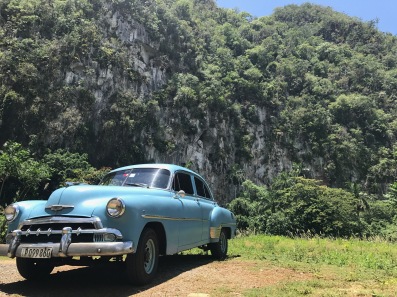
I slid a stack of Euros under the glass partition at the currency window and waited. Cuba has an exchange tax on U.S. currency, so to save money I’d traded out the bills the day before. The officer on the other side of the window divvied up two piles of Cuba’s two currencies. The CUC which is used for tourists and set at a 1:1 fixed rate against the Dollar. And the CUP, or Cuban Peso, which is worth far less, and used at ration stores and street stalls selling juices and assorted fruits.
We piled into the back of a faded blue 1961 blue Chevy, and made our way towards Havana, roughly half an hour away. It was a time traveling trip where everyone shared the road. Antique cars rumbled over potholes, while improvised horse drawn buggies trotted alongside, trying to keep up. Mopeds, which appeared to be held together with duct tape and pieces of erector sets, sped through the traffic. Backfiring as they shifted gears and raced around the ancient automobiles. Not to be outdone, bicyclists with boxes of fruit and other household goods strapped and stacked higher than the riders themselves, peddled along the sidewalks, leaving beads of sweat in the dirt behind them.
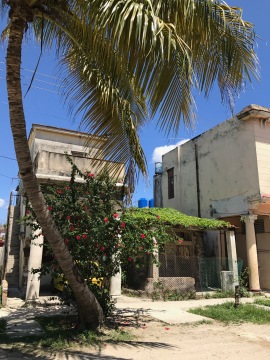 We drove past dilapidated buildings with chipped paint, cracked windows, and exposed blocks of concrete set behind pro-revolutionary billboards of Fidel Castro coolly smoking cigars. Clothes, gently swaying in the warm, sticky breeze were pinned along clotheslines attached from one tin roof corner to the other.
We drove past dilapidated buildings with chipped paint, cracked windows, and exposed blocks of concrete set behind pro-revolutionary billboards of Fidel Castro coolly smoking cigars. Clothes, gently swaying in the warm, sticky breeze were pinned along clotheslines attached from one tin roof corner to the other.
The homes gradually turned more pleasing as we neared our hotel; a one-hundred-year-old mansion in a quiet section of south Havana. The house-turned-hostel was nestled amongst a depressed collection of homes, each one hidden behind beautiful bougainvillea, banana palms, and multi-colored hibiscus bushes. The outside of our hostel was tattered with years of disregard, but the interior boasted a carefully preserved décor of spotless Italian marbled floors and imported onyx columns that supported frescoed ceilings.
In the communal bathroom, water slowly dripped from the sink faucet regardless of how hard the nozzle turned or which direction it went. There were half a dozen rooms, each with ten-foot hand crafted wooden doors that even when fully opened, required a sideways entry.
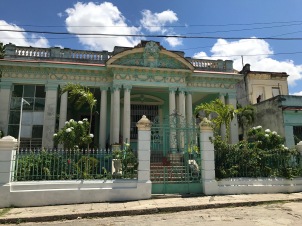
The streets were caked with broken bits of asphalt, piles of dirt from unfinished roadwork and an assortment of other debris. Trash cans were overflowing with flies circling above, hoping the garbage trucks would forget to make their runs.
We found our way to The Malecón; an esplanade roadway where the ocean kisses a 5-mile stretch of the Havana coastline. It’s a popular hangout for those who have very little and are looking for entertainment without a cost. We stopped there to capture a few images of life along the wall, when we struck up a conversation with two locals who were offering a tour through the city in a 1952 Chrysler.
After negotiating a price, we scooted into the backseat where the carpet on the floor had been removed, displaying a metal that hadn’t seen the light of day since it rolled off the assembly line. This car was born a few years before seat belts. So, the head rest on the seat in front of me would have to do. Lowering the window to allow fresh air, I cranked the handle – delicately – as if I were churning butter. Everything about the car was original. From the engine and the paint, to the steering wheel and its radio knobs. Everything except the Boss Stereo system that lived in the glove box.
Elon, our navigator, fiddled with the stereo, while Carlito, our driver, pointed out landmarks. So much was happening…and all at the same time. In-between shout-outs, Carlito struggled to keep the door from falling off its hinges. Opening and closing it in rapid succession to get the latch to catch properly. That, while a bassline of reggae-infused Spanish music thumped through crackling speakers, with a decibel level so loud it may have interrupted communications with the International Space Station.
It was our very own Cuban/American Graffiti moment, passing a collection of vintage American cars, while cruising the streets of Havana with music blaring. We stopped several times to take video and pictures. And as our tour guides explained the relevance of what we were seeing, we were wondering when the door might fall off completely.
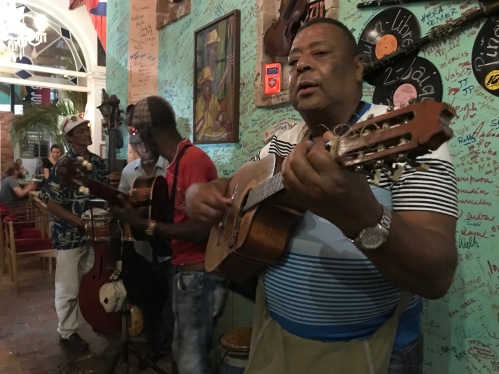
We pulled into a bar – a juke-joint type of place – where Mojitos were made on the small patio, and live salsa and merengue music was made in the room next door.
“Mr. Obama sat right here and drank a Mojito!” Carlito told us proudly, while ordering us the same drink.
“You don’t want one?” I asked.
“No.” he shot back, disappointingly.
“I can’t afford them…it costs 6 CUC. Revolution is a bitch.”
We ordered drinks for them both, then sat down at a corner table. In hushed tones, we started talking about things locals weren’t supposed to be talking to tourists about – things they couldn’t do:
- Travel abroad without permission.
- Change jobs without permission.
- Read unapproved books or magazines.
- Visit or stay in tourist hotels.
Their list went on.
While they were ticking off the “Do-Not’s” of a Cuban citizen, a drunk man staggeringly made an unwelcomed entrance at our table. Interrupting our conversation with slurred speech, he called our friends prostitutes and chastised them for conversing with “the westerners.” A bouncer forcibly removed the man, pushing him back onto the street. I watched him walk away, teetering and talking to himself as he disappeared around the corner.
Finishing our drinks, we climbed back into the car as Elon reached for the stereo before slamming the door. Cranking Bonnie Tyler’s, Total Eclipse of the Heart, to an uncomfortable level, we sped off.
“You want some cigars?” Elon asked. “I know just the place.” We’d said, no. But Carlito was singing the “Turn Around Bright Eyes” chorus so loudly, neither of them heard us.
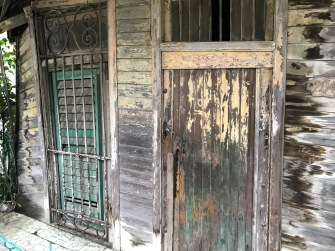 Winding through a narrow alley in a neighborhood where the streets truly had no name, our Chrysler careened its way around pedestrians. It wasn’t the derelict environment that stood out, in so much as it was the idleness of those living in it. Everyone seemed to be waiting for something to happen. Some squatted inside entryways where the doors had long since vanished, and others wandered the street aimlessly.
Winding through a narrow alley in a neighborhood where the streets truly had no name, our Chrysler careened its way around pedestrians. It wasn’t the derelict environment that stood out, in so much as it was the idleness of those living in it. Everyone seemed to be waiting for something to happen. Some squatted inside entryways where the doors had long since vanished, and others wandered the street aimlessly.
Carlito pulled the car up alongside a corner and stopped, abruptly, with the left front tire slightly scraping the sidewalk. Exiting quickly, the four of us headed down a dark, dingy passageway to meet a man we didn’t know so we could buy cigars we would never smoke.
The smell of urine hung in the warm air as Elon reached through wrought iron bars and banged heavy on an even heavier wooden door. “Julio!” he called out. Banging a few more times. No answer. I got the impression “Julio” hadn’t been around for a while…seeing as how there was a giant padlock on the front of his door. Satisfied Julio would not be selling us Montecristo’s, we climbed back into the Chrysler and bounced our way down the broken street once more.
The day was getting away from us and it was time for dinner. We chose, at the behest of our new friends, La Familia. One of Havana’s many paladeras – privately owned small businesses used as restaurants.
La Familia’s food was simple and home cooked; black beans, rice and half a chicken. There was nothing fancy about it. But we preferred it that way. It reminded us that those who prepared it weren’t professionals. They just simply enjoyed cooking it for us. The ambiance far outweighed the meal, as family pictures of people long since passed hung crookedly on the wall, and newspaper articles lined every inch of the ceiling. Two guitar players performed acoustic Spanish renditions of James Taylor songs in the far corner, as the patrons sang along in between bites.
With dinner over we set out in search of a Wi-Fi Hot Spot. Cuba has the lowest internet density in the Western Hemisphere. Less than 2% of the population even has access. And although the government is slowly lifting those restrictions, this a country where not that long ago chewing gum was illegal.
With only half-a-dozen hotspots in Havana, we stumbled into a park where hundreds of people sat shoulder-to-shoulder on benches and sidewalks. A fluorescent glow bouncing off their faces, signaled to us we’d found one of the six. We bought a one-hour internet card for 4 CUC from a kid who looked as if he were selling fake Rolex’s. The cards had a scratch off username and password on the back that when scraped away, revealed a long set of random digits and symbols. Everything we surfed was being monitored by the government. And the speed at which we were doing so was the equivalent of two hamsters running in a cage to activate the filament of a lightbulb. An hour’s worth of internet service was barely enough time to send a few texts and answer an email. Skype didn’t work, and a simple phone call distorted the voice on the other end, turning their speech patterns into an alien lifeform with an indecipherable language.
It had been a long day and we’d seen quite a bit. So, as a self-anointed “cork dork” I felt a nice Cabernet would be a good way to say goodnight to Day 1. We hadn’t seen a wine shop all day. And if one existed, our guess was that it would be in the center of downtown Havana. Standing outside El Capitoilo Nacional, we heard a voice from behind. “I can find you wine! 1 CUC per bottle.” The voice said.
We’d been chauffeured all day successfully. And while I was skeptical of a taxi driver promising dollar-a-bottle wines, I figured there was no harm in searching.
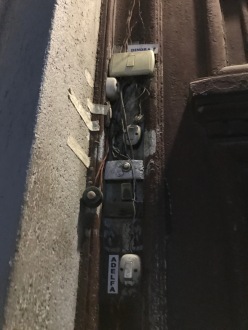 The darkness did little to hide the fractured facades of the homes we drove past. And as our car came to rest in front of a nondescript door, I took notice of the dozen or so doorbells, each one connected with exposed wires that shot off in all directions. Careful not to touch anything, I traced my finger along the wires, trying to find the doorbell that matched the wine store.
The darkness did little to hide the fractured facades of the homes we drove past. And as our car came to rest in front of a nondescript door, I took notice of the dozen or so doorbells, each one connected with exposed wires that shot off in all directions. Careful not to touch anything, I traced my finger along the wires, trying to find the doorbell that matched the wine store.
“Put your CUC in the bucket.” Our driver said from behind me. Pointing to a small sign above the door that read simply, “Vino!”
“What do you mean, ‘the bucket?’” I asked.
“Your money.” He replied. “Put it in here and I’ll send it up there.”
‘Up there!” was a fourth-story balcony where the bucket had just been dropped, hand-over-hand with a frayed rope.
There were four bottles to choose from. And while I knew slightly more about wine than the average person, I was more than confident the listed varietals were made up.
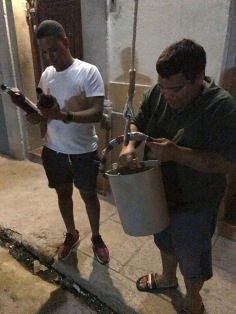
Figuring we’d been had, we decided to buy all four. Which, we believed, would raise the chances of at least one bottle tasting better than cough syrup.
I dropped a 5 CUC bill into the bucket and watched as it ascended upward towards a shadowy figure on a balcony just below the roof. The figure, never saying a word, pulled the bucket over the ledge and disappeared. Within seconds, four separate sounds of glass against tin echoed through the street as I stood underneath … waiting with outstretched arms.
Retrieving the bottles of God-knows-what from the bucket, we got back into the car and drove towards the hostel over an uneven and bumpy street. Our bottles clanking together on the seat between us, as we wondered – aloud – what they were going to taste like. And what in the world the rest of the week had in store for us.
